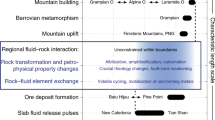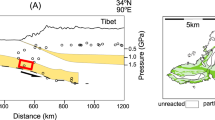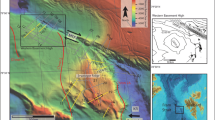Abstract
The metamorphic cycle associated with the formation of mountain belts produces a lower crust containing little or no free fluid1,2. The introduction of external fluids to dry and impermeable volumes of the Earth's crust is thus a prerequisite for the retrogressive metamorphism later observed in such regimes. Such metamorphism can cause significant changes in the crust's physical properties, including its density, rheology and elastic properties3,4. On a large scale, the introduction of fluids requires the presence of high-permeability channels, such as faults or fractures, which are the result of external tectonic stresses. But extensive interaction between externally derived fluids and the fractured rock requires efficient mass transport away from the initial fractures into the rock itself, and this transport often occurs over distances much longer than expected from grain-boundary diffusion. Here we present both field observations and a simple network model that demonstrate how the transport of fluids into initially dry rock can be accelerated by perturbations in the local stress field caused by reactions with fluids. We also show that the morphology of reaction fronts separating ‘dry’ from ‘wet’ rocks depends on the anisotropy of the external stress field.
This is a preview of subscription content, access via your institution
Access options
Subscribe to this journal
Receive 51 print issues and online access
$199.00 per year
only $3.90 per issue
Buy this article
- Purchase on Springer Link
- Instant access to full article PDF
Prices may be subject to local taxes which are calculated during checkout





Similar content being viewed by others
References
Yardley, B. W. D. in Fluid Flow and Transport in Rocks: Mechanisms and Effects (eds Jamtveit, B. & Yardley, B. W. D.) 99–121 (Chapman and Hall, London, 1997).
Yardley, B. W. D. & Valley, J. W. The petrologic case for a dry lower crust. J. Geophys. Res. 102, 12173–12185 (1997).
Austrheim, H. Eclogitization of lower crustal granulites by fluid migration through shear zones. Earth Planet. Sci. Lett. 81, 221– 232 (1987).
Austrheim, H. Eclogite formation and the dynamics of crustal roots under continental collision zones. Terra Nova 3, 492– 499 (1991).
Sturt, B. A., Skarpenes, O., Ohanian, A. T. & Pringle, T. R. Reconnaissance Rb/Sr isochron study in the Bergen Arc System and regional implications Nature 253, 595– 599 (1975).
Bingen, B., Davis, W. J. & Austrheim, H. Zircon growth during fluid induced Caledonian/Scandian eclogite-facies metamorphism of the Lindås Nappe, Caledonides of W Norway. Min. Mag. A 62, 161–162 (1998).
Jamtveit, B., Bucher-Nurminen, K. & Austrheim, H. Fluid controlled eclogitization of granulites in deep crustal shear zones, Bergen Arcs, western Norway. Contrib. Mineral. Petrol. 104, 184–193 ( 1990).
Rockow, K. M., Haskin, L. A., Jolliff, B. L. & Fountain, D. M. Constraints on element mobility associated with the conversion of granulite to eclogite along fractures in an anorthositic complex on Holsnoy, Norway. J. Metamorph. Geol. 15, 401– 418 (1997).
Wheeler, J. The significance of grain-scale kinetics of metamorphism. Contrib. Mineral. Petrol. 97, 397–404 (1987).
Kirkaldy, J. S. in Growth, Dissolution and Pattern Formation in Geosystems (eds Jamtveit, B. & Meakin, P.) 189–220 (Kluwer, Dordrecht, 1999).
Cundall, P. A. & Strack, O. D. L. A discrete numerical model for granular asssemblies. Geotechnique 29, 47–65 (1979)
de Arcangelis, L. & Reder, S. A random fuse model for breaking processes. J. Phys. Lett. 46, L585–L590 (1985).
Herrmann, H. J. & Roux, S. Statistical Models for the Fracture of Disordered Media. (North-Holland, Amsterdam, 1990).
Herrmann, H. J., Hansen, A. & Roux, S. Fracture of disordered, elastic lattices in two dimension. Phys. Rev. B 39, 637–648 (1989).
Malthe-Sorenssen, A. et al. Simulation of extensional clay fractures. Phys. Rev. E 58, 5548–5564 ( 1998).
Yakobson, B. I. Morphology and rate of fracture in chemical decomposition of solids. Phys. Rev. Lett. 67, 1590–1593 (1991).
Farver, J. R. & Yund, R. A. Oxygen bulk diffusion measurements and TEM characterization of a natural ultramylonite: implications for fluid transport in mica-bearing rocks. J. Metamorph. Geol. 17, 669–683 (1999).
Roark, R. J. & Young, W. C. Formulas for Stress and Strain (McGraw Hill, Tokyo, 1975).
Allen, D. M. de G. Relaxation Methods (McGraw-Hill, New York, 1954).
Acknowledgements
This work was funded by the Norwegian Research Council through a grant to the Strategic University Program ‘Fluid Rock Interactions’. We thank J. Feder, P. Meakin and the other members of the Fluid Rock Interaction group for valuable suggestions and discussions and A. Kühn and M. Lund for providing some of the figures.
Author information
Authors and Affiliations
Corresponding author
Rights and permissions
About this article
Cite this article
Jamtveit, B., Austrheim, H. & Malthe-Sørenssen, A. Accelerated hydration of the Earth's deep crust induced by stress perturbations . Nature 408, 75–78 (2000). https://doi.org/10.1038/35040537
Received:
Accepted:
Issue Date:
DOI: https://doi.org/10.1038/35040537
This article is cited by
-
Si- versus Mg-metasomatism at the crust–mantle interface: insights from experiments, natural observations and geochemical modeling
Progress in Earth and Planetary Science (2023)
-
Twinning and partial melting as early weakening processes in plagioclase at high pressure: insights from Holsnøy (Scandinavian Caledonides, Norway)
Contributions to Mineralogy and Petrology (2023)
-
Orange hydrogen is the new green
Nature Geoscience (2022)
-
Mechanism of Fault Terminations: Theory and Field Examples
Journal of the Geological Society of India (2022)
-
Reactive fluid flow guided by grain-scale equilibrium reactions during eclogitization of dry crustal rocks
Contributions to Mineralogy and Petrology (2022)
Comments
By submitting a comment you agree to abide by our Terms and Community Guidelines. If you find something abusive or that does not comply with our terms or guidelines please flag it as inappropriate.



